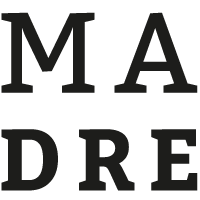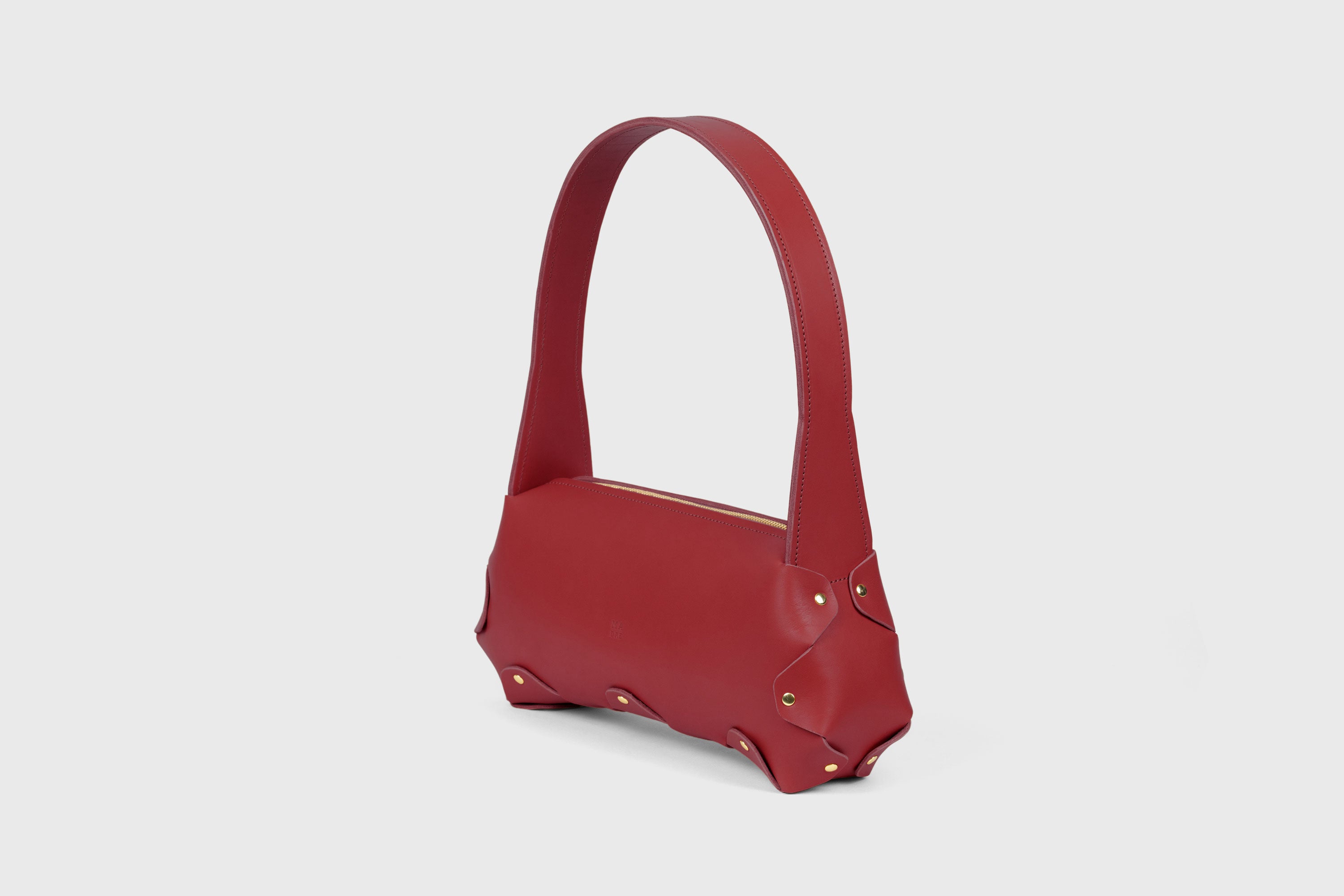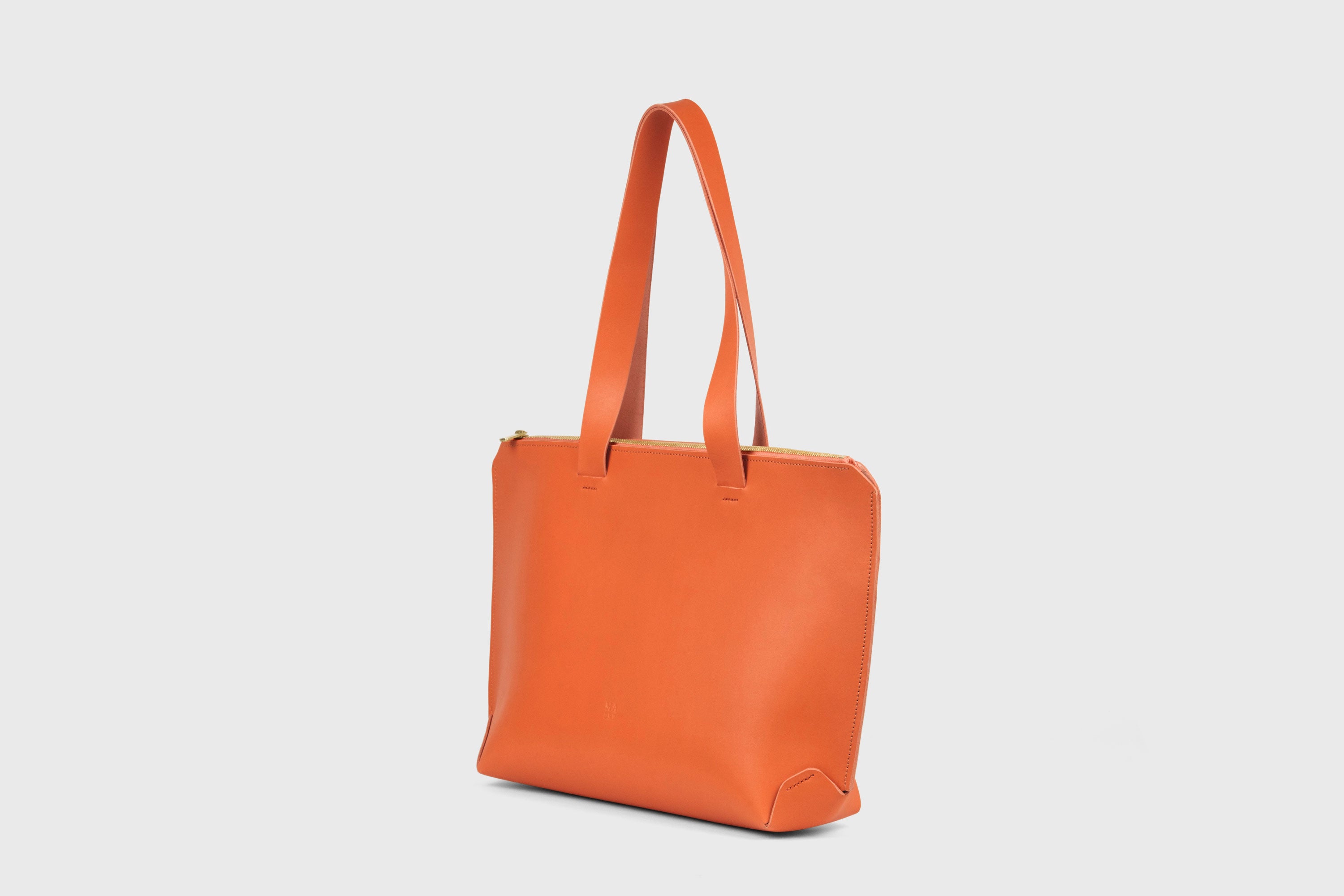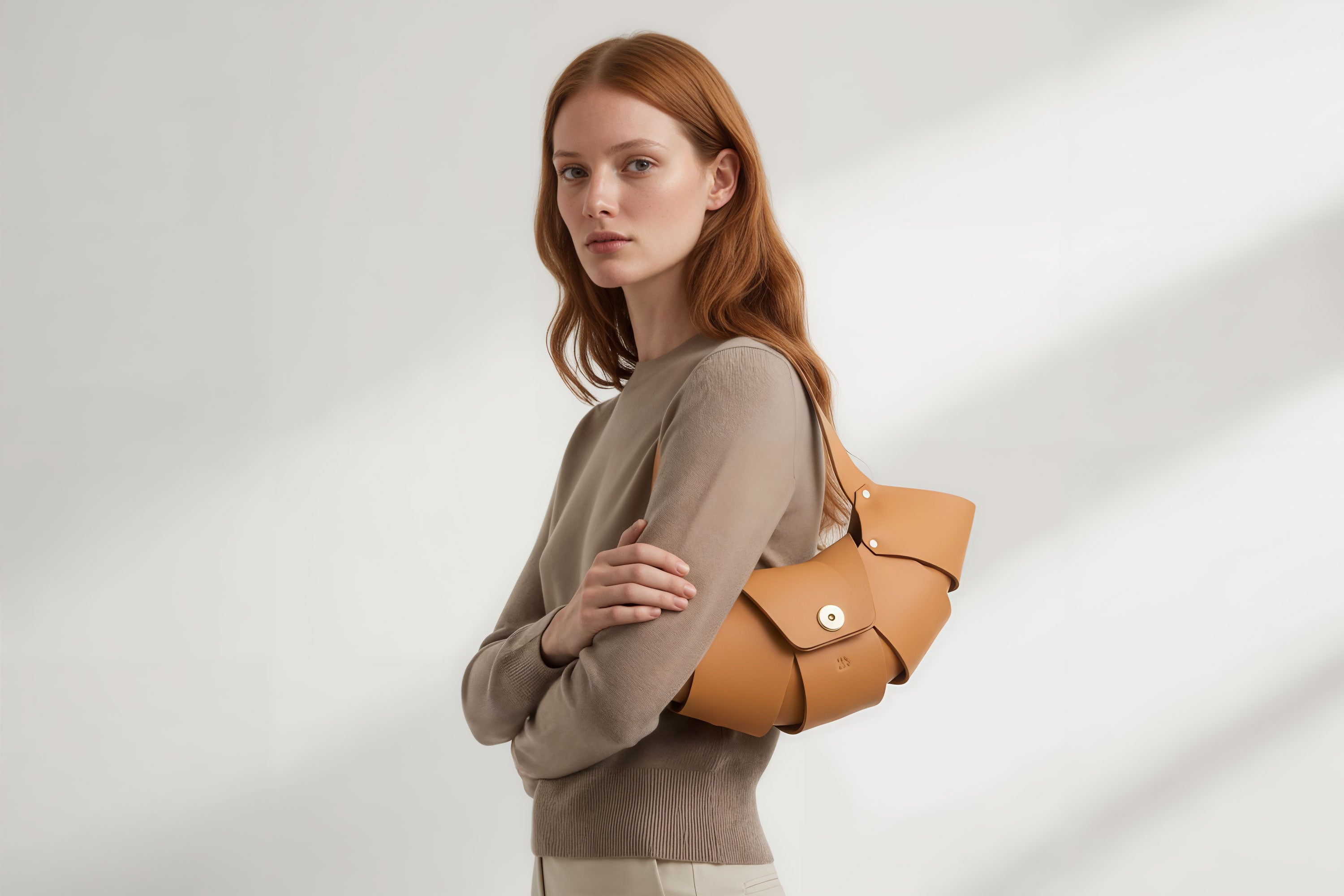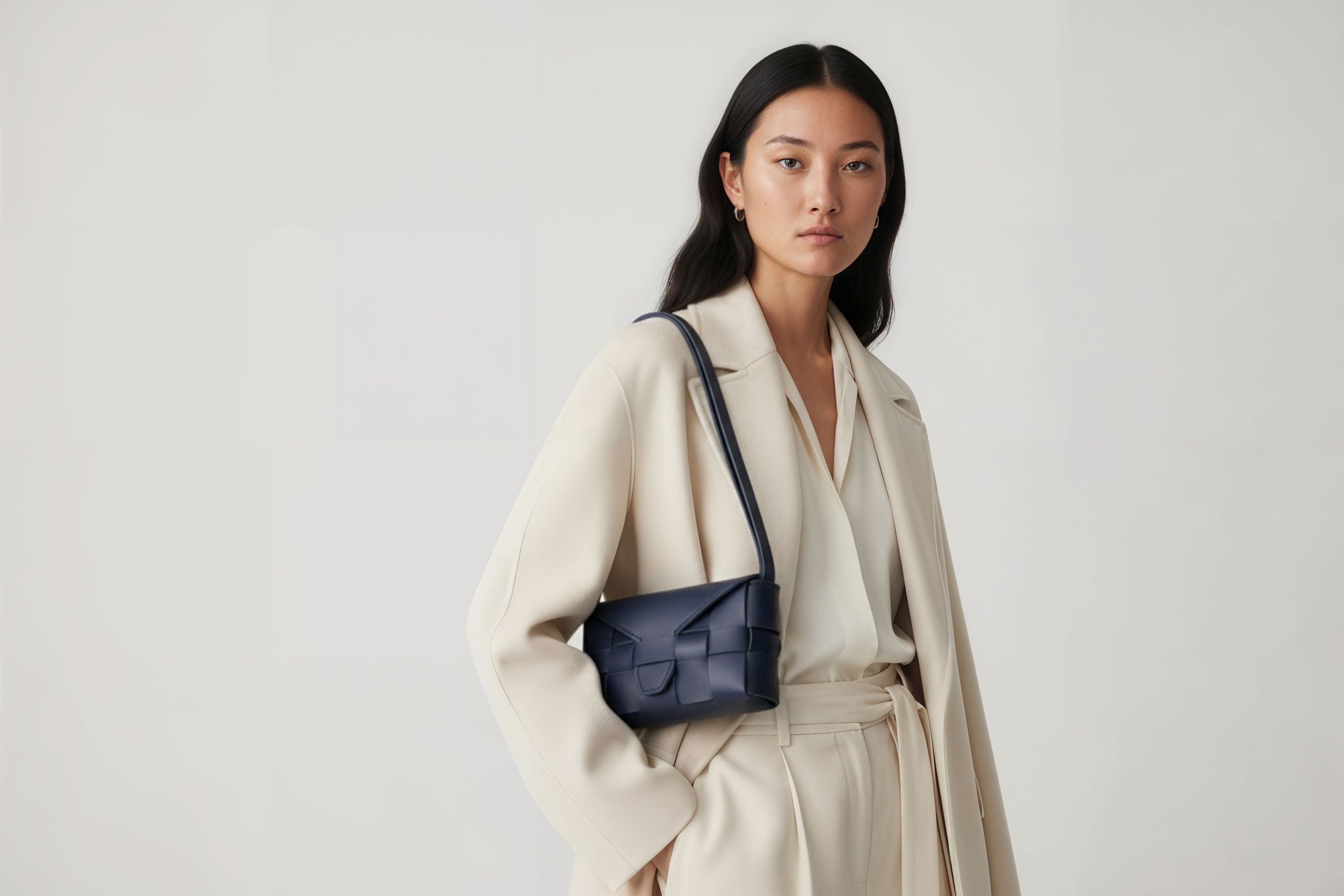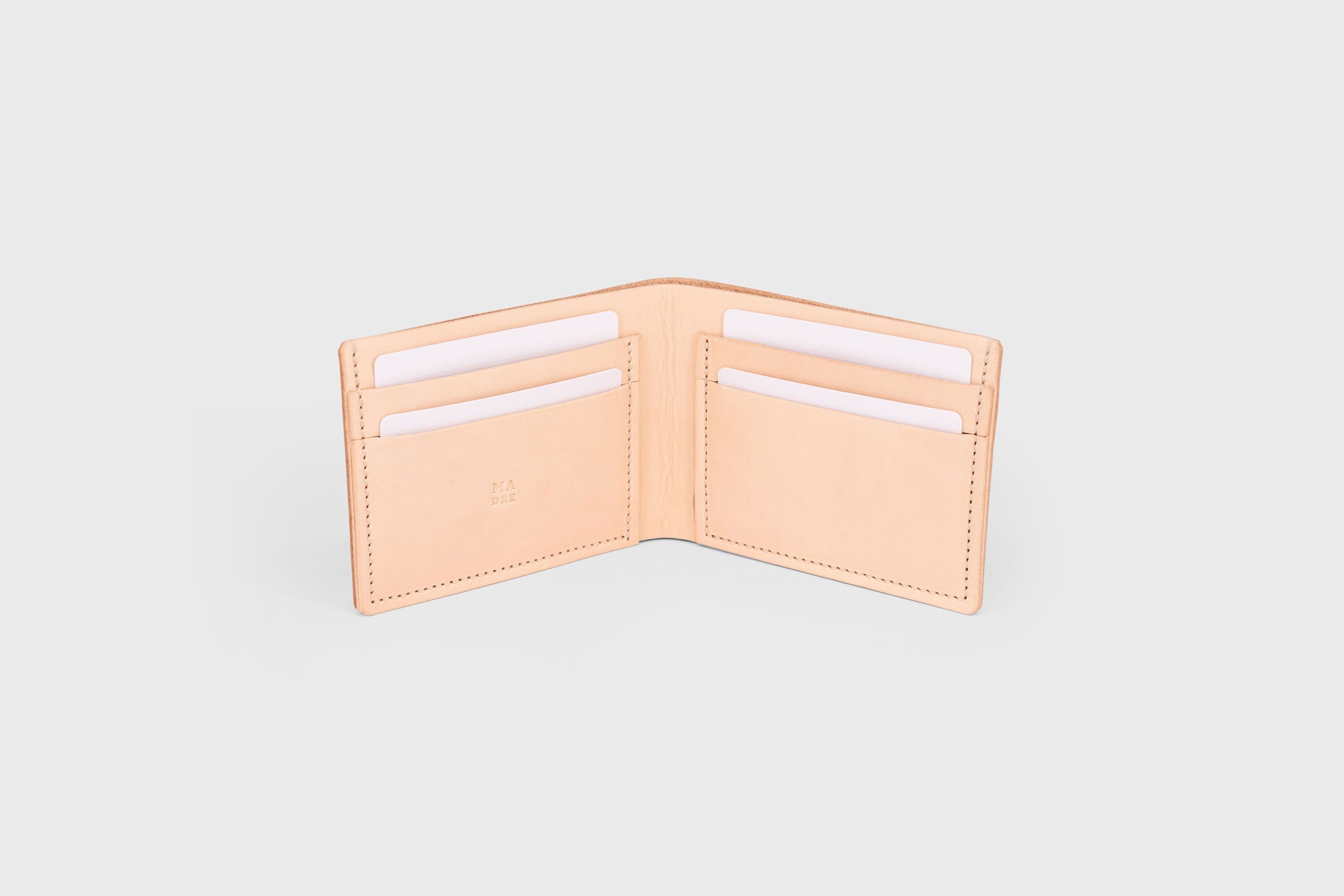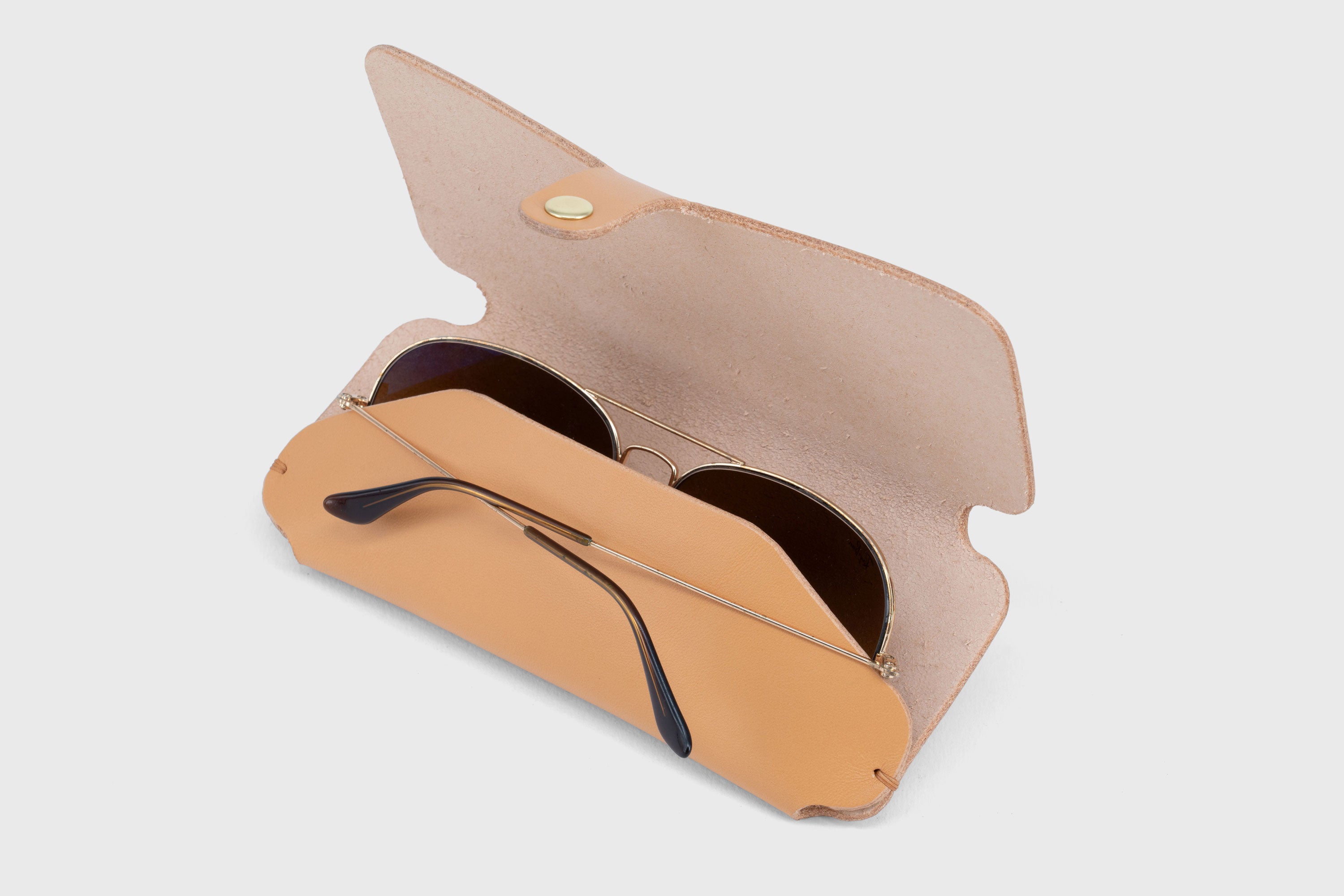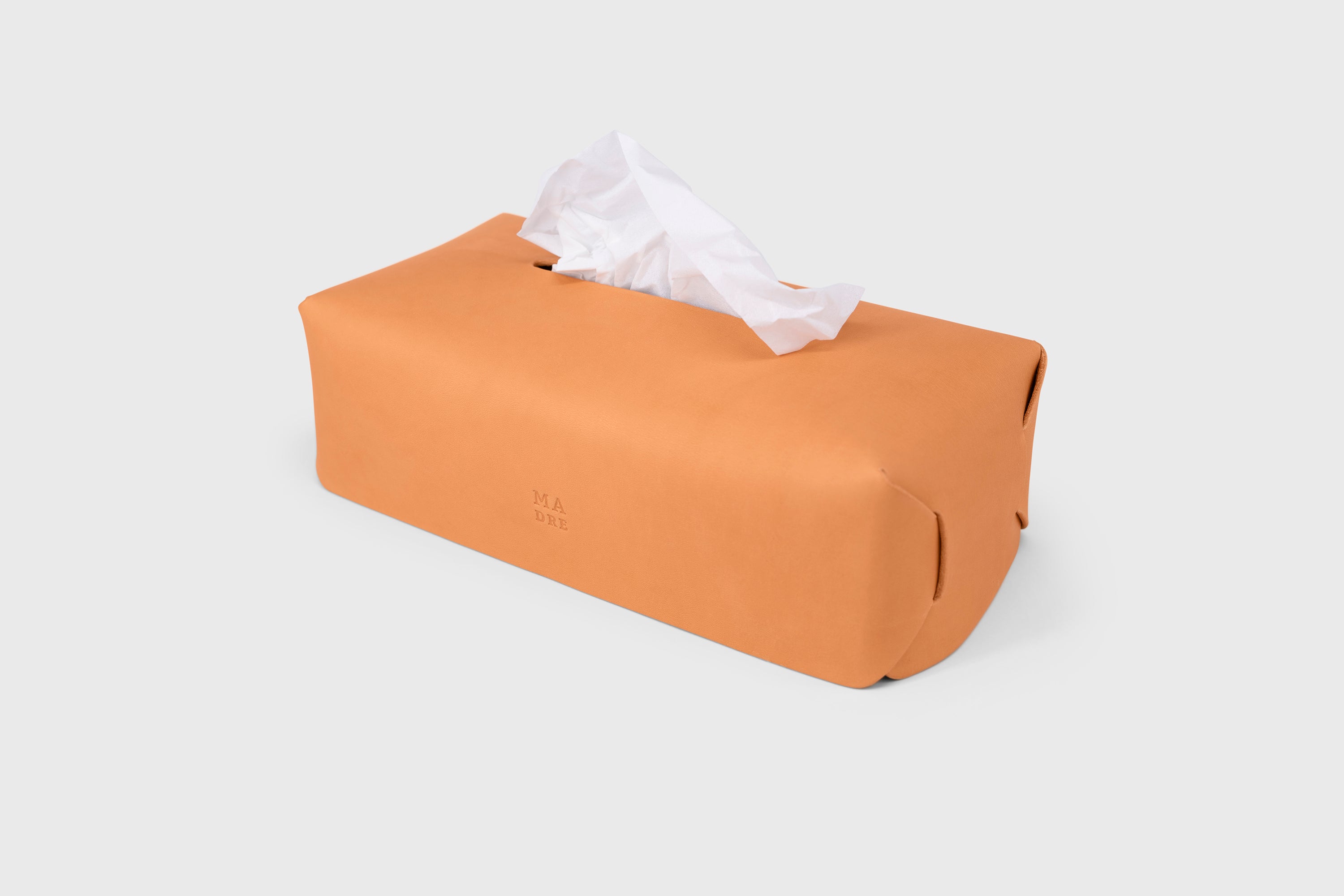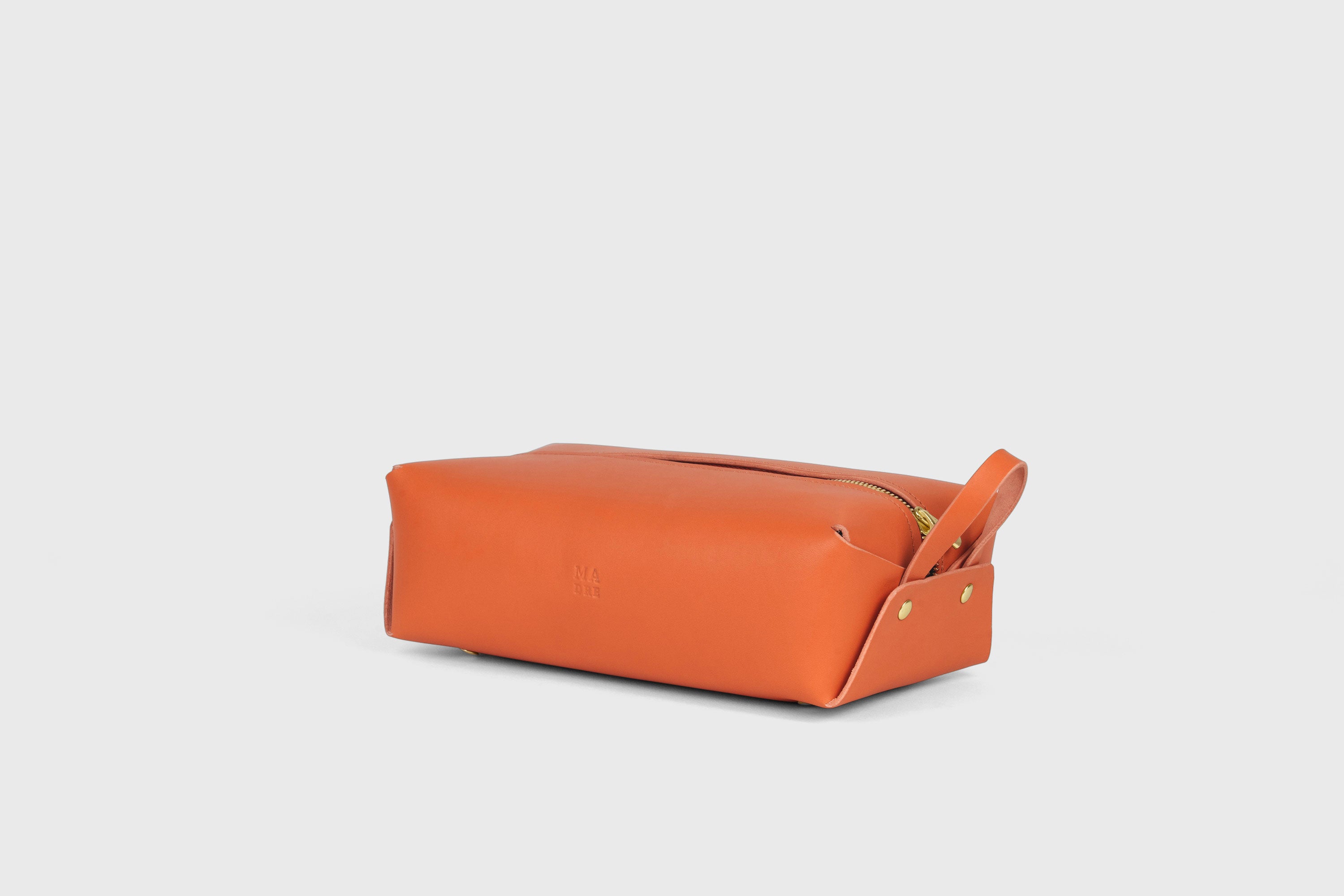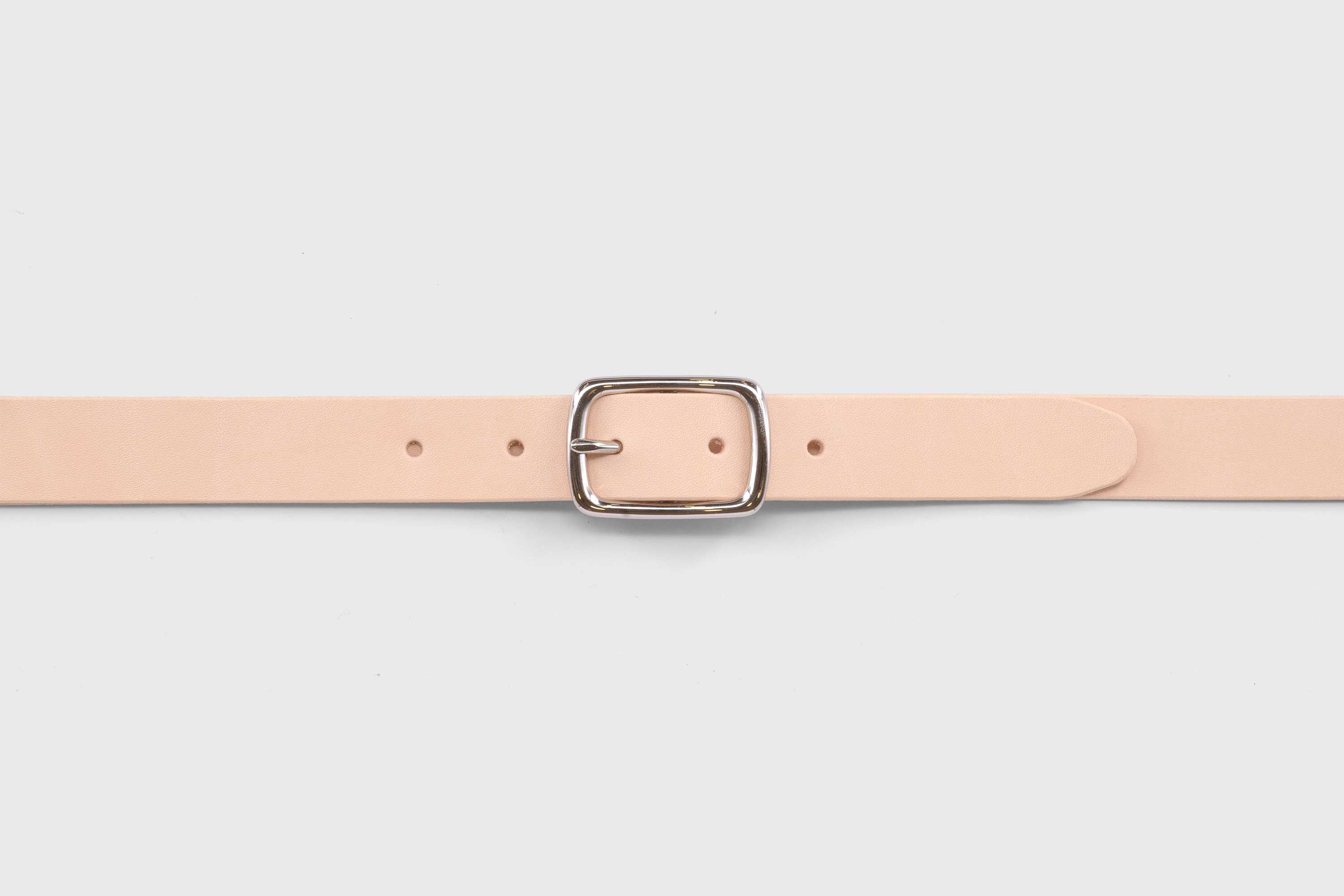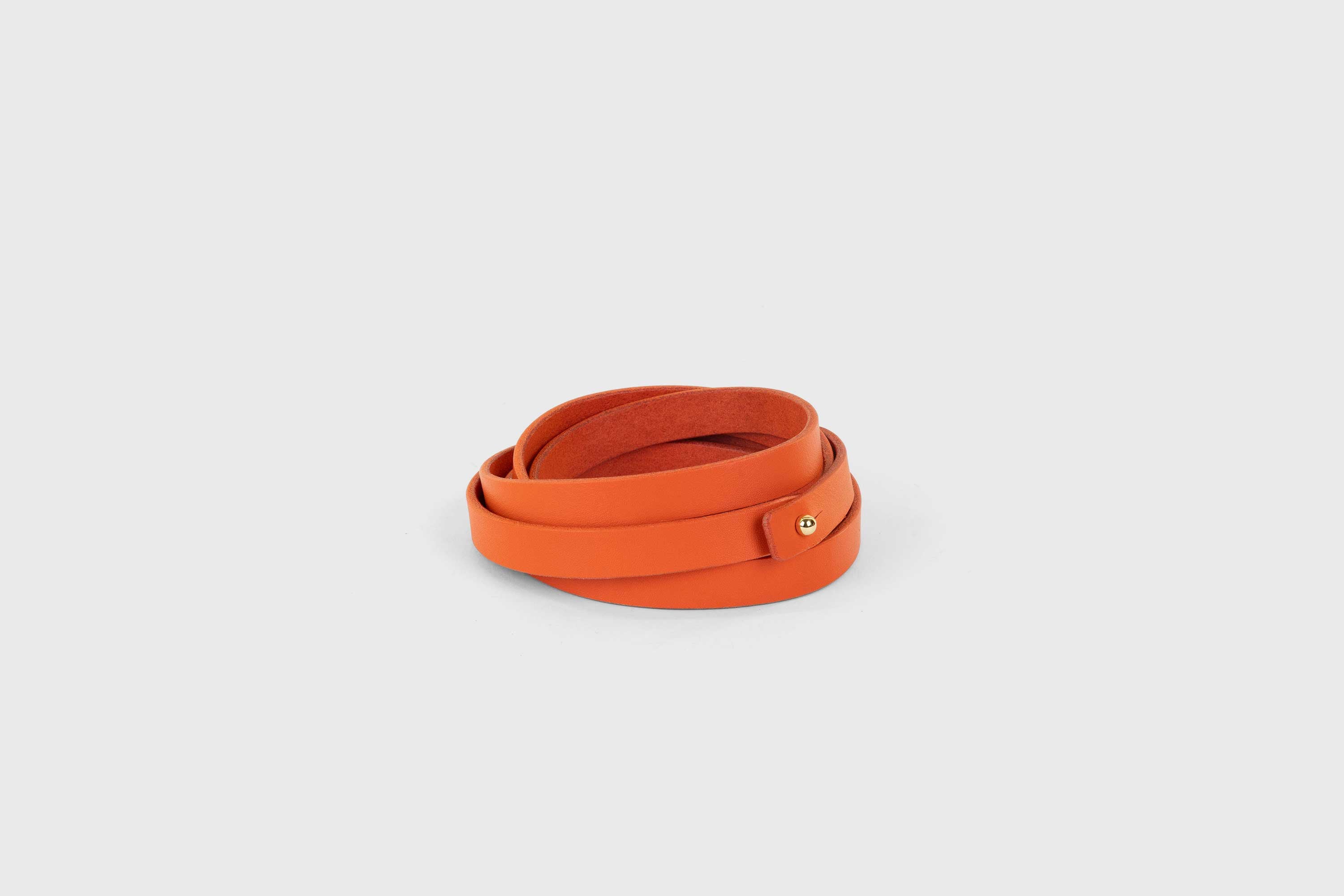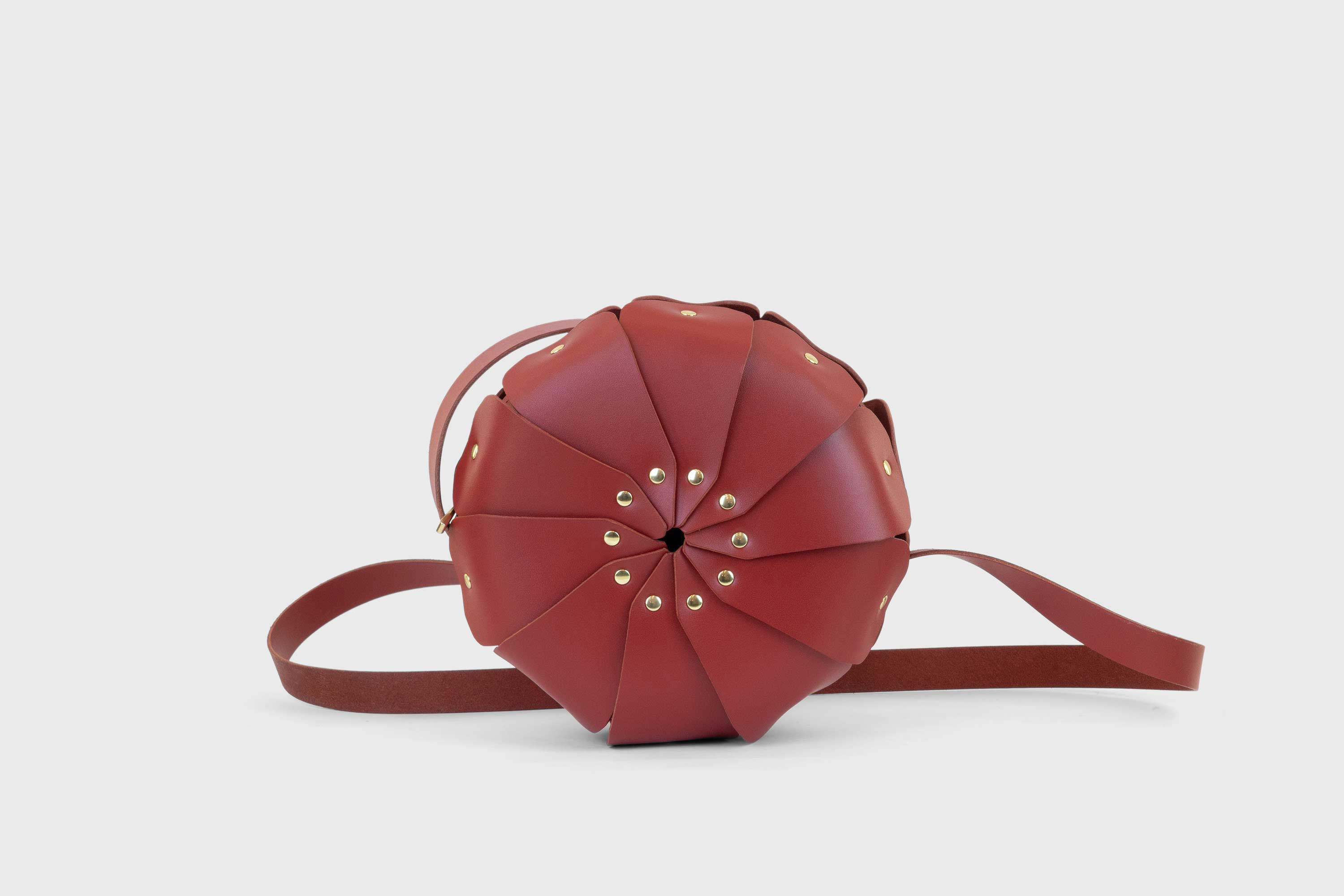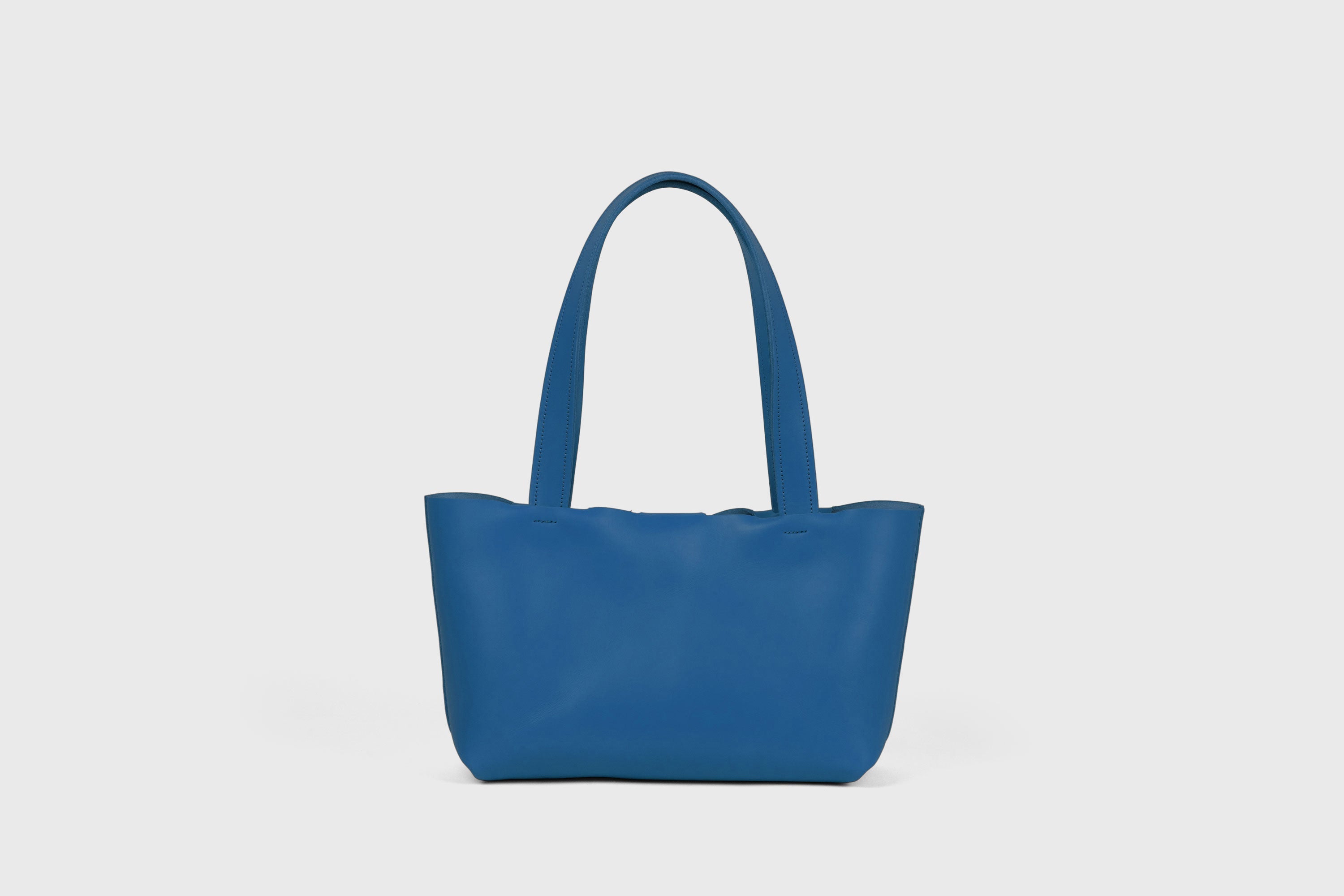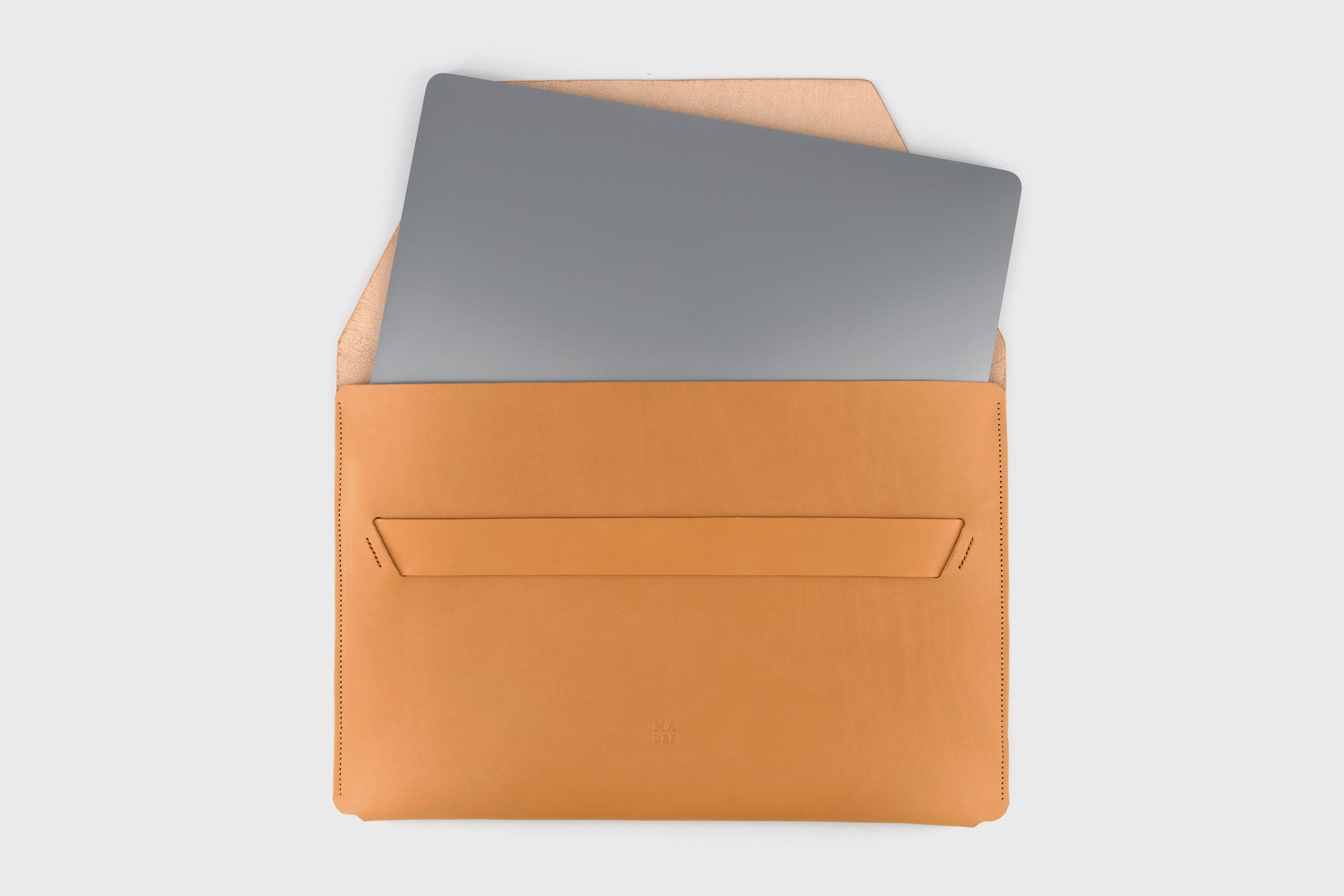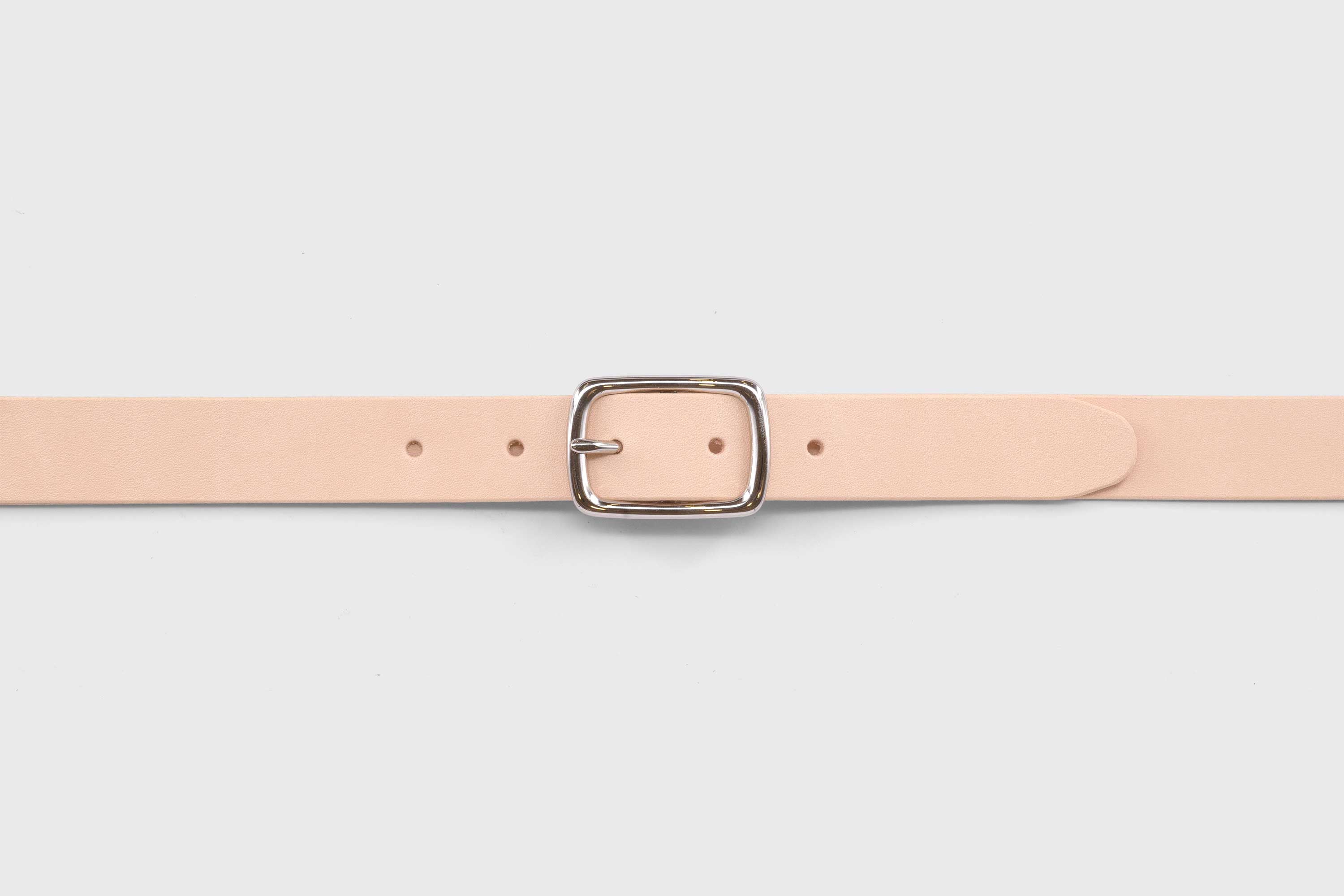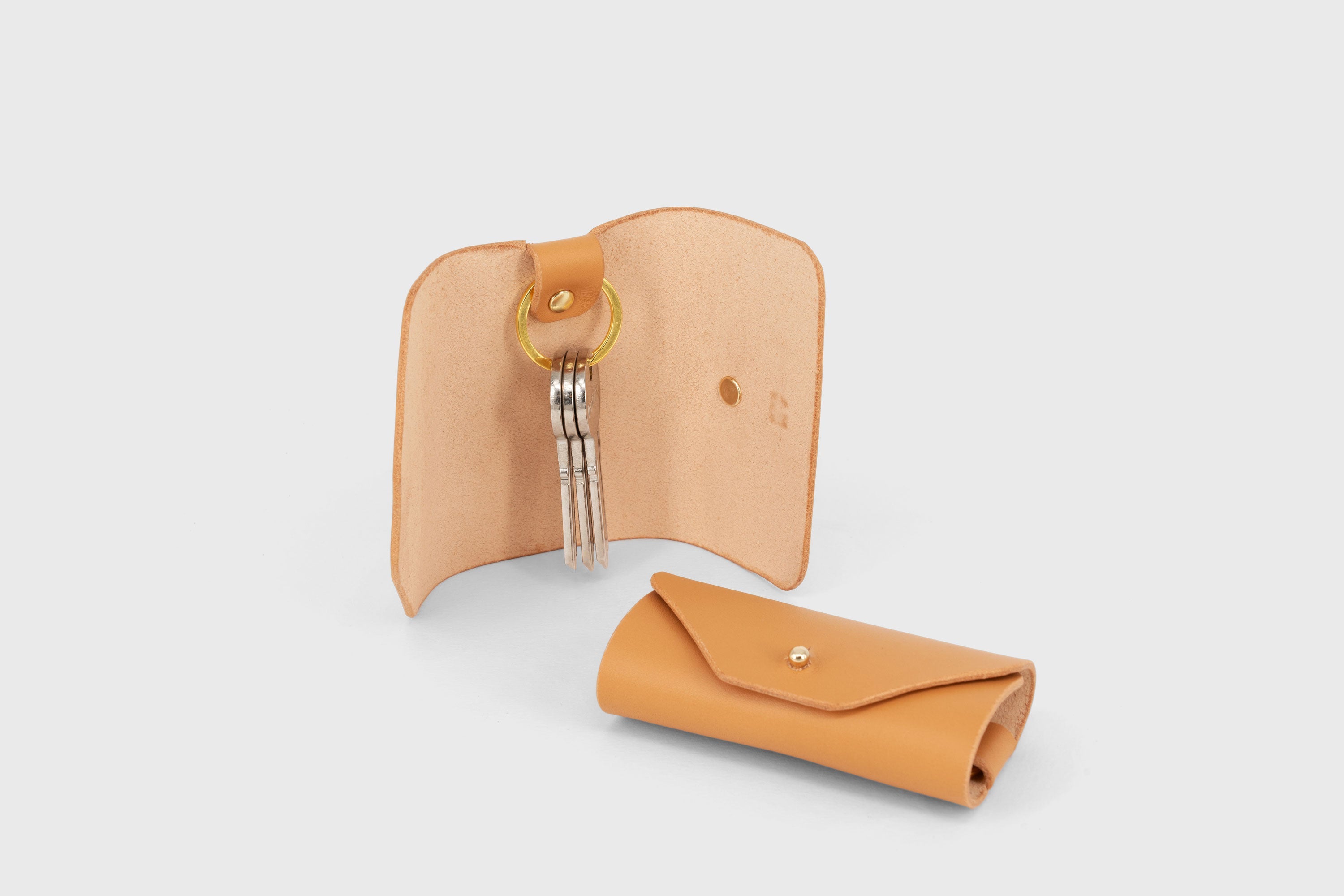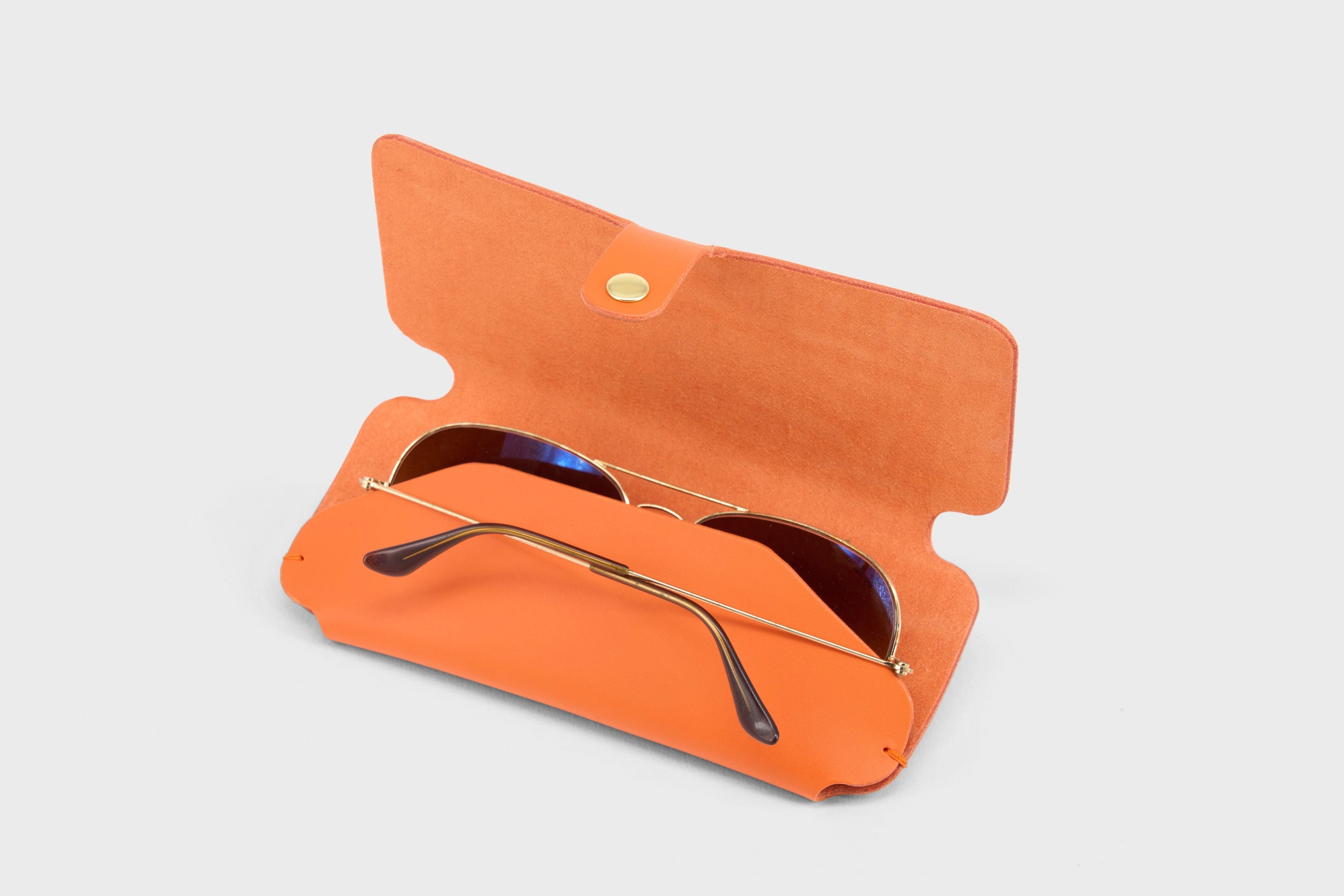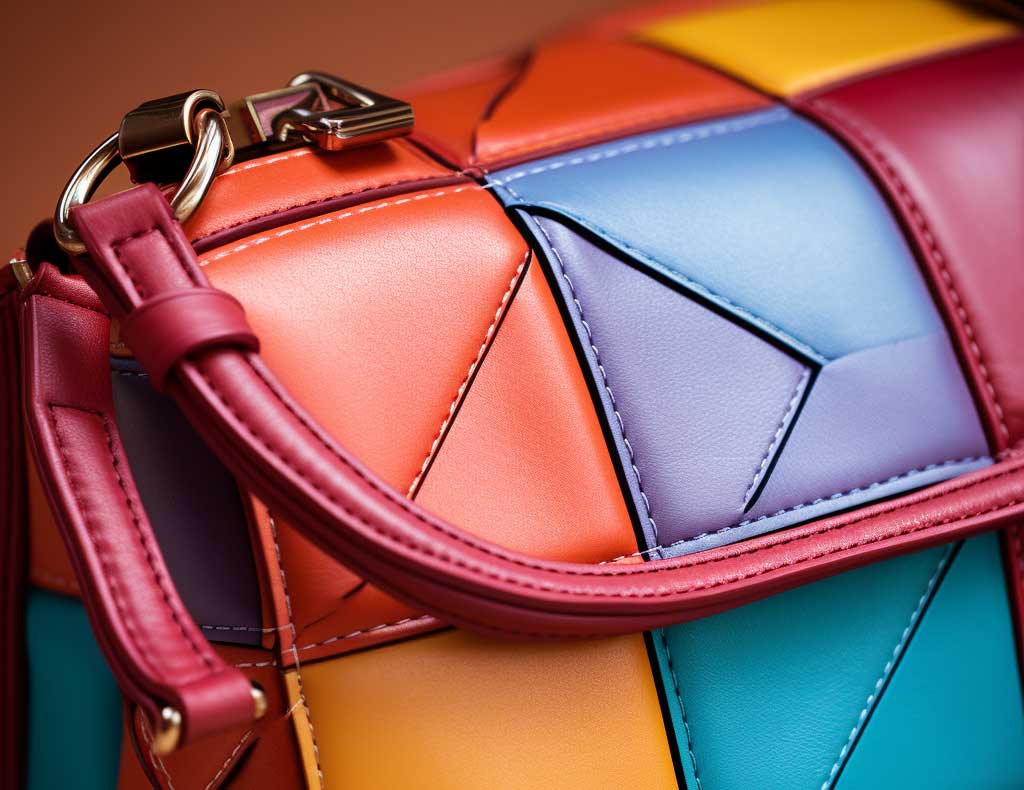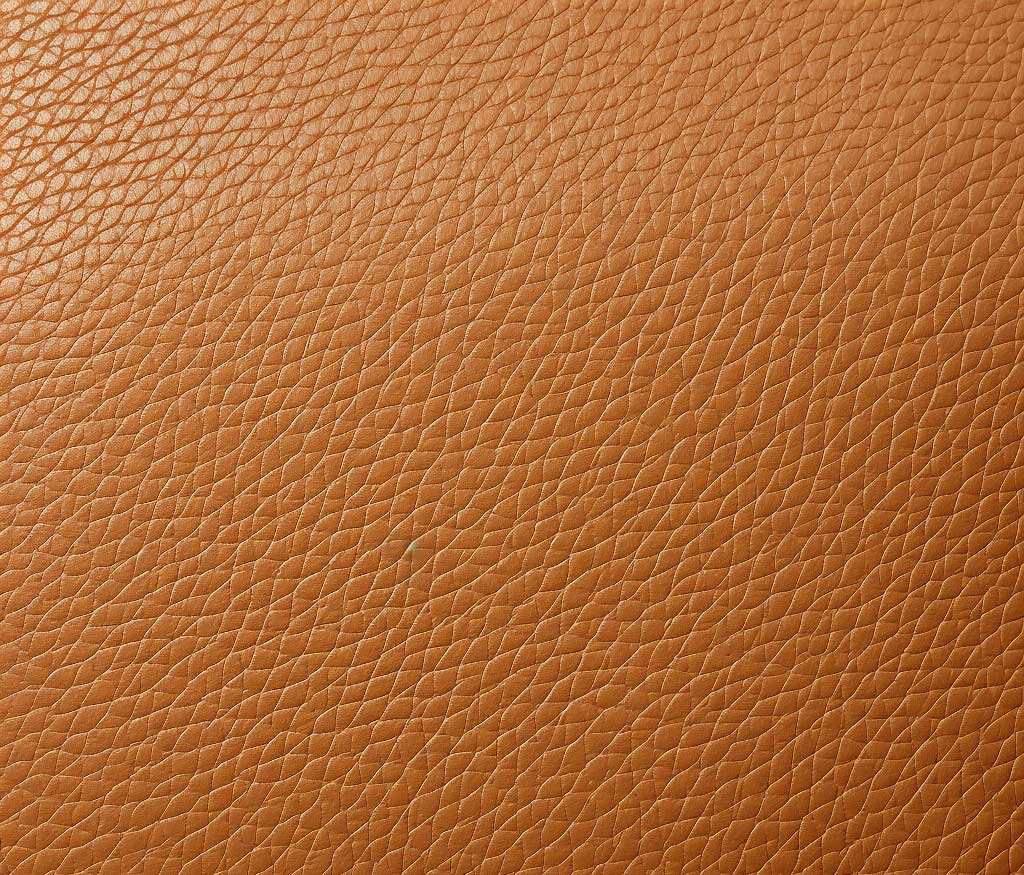
What is Top Grain Leather: Quality, Durability, and More
In the world of leather, the term 'Top Grain' often pops up, creating a wave of questions about its quality, durability, and where it fits in the grand hierarchy of leather types. This article will delve into the heart of top grain leather, exploring its unique properties, how it's produced, and how it fares against its other leather counterparts. We'll also shed light on why Atelier Madre, a company known for its meticulous craftsmanship and commitment to sustainability, opts for full grain vegetable tanned leather over top grain leather for its premium collection of bags and accessories. Strap in as we embark on this leathery journey, unravelling the fascinating world of top grain leather.
Is Top Grain Leather Real Leather? A Deeper Look
Top grain leather is indeed considered real leather, but it's important to understand that not all leathers are created equal. Leather is generally classified based on the process of production and the part of the animal hide used.
What is Top Grain Leather?
Top grain leather is the second-highest quality of leather after full-grain leather. It comes from the outer layer of the hide, but unlike full-grain, the very top layer of the hide containing the natural imperfections and unique patterns is sanded away. A new finish coat is then applied to give it a more uniform appearance. This process removes scars, blemishes, and other imperfections, giving the leather a smooth and consistent look.
Quality and Durability:
Although top grain leather is considered real leather, the sanding and coating process it undergoes affects its durability and the way it ages. While it is more resistant to stains than full-grain, it does not develop the same rich patina and character over time. This is one of the reasons why at Atelier Madre, we prefer using full grain leather which retains the hide in its most natural and durable state.
In Summary:
So, to answer the question - Yes, top grain leather is real leather. However, it's a step down from full grain leather in terms of durability and ageing characteristics. Whether top grain leather is the right choice for you depends on your preferences for appearance, durability, and the unique ageing characteristics of your leather goods.
Navigating the Leather Hierarchy: Unraveling the 4 Distinct Grades
Leather – a material as ancient as civilization itself, has long been associated with luxury, durability, and elegance. But did you know that not all leathers are created equal? Over time, industry experts have categorized leather into four primary grades. These grades define the quality, feel, and application of the leather. Let's embark on a journey through the tiers of leather quality.
-
Full Grain Leather:
- Description: This is the crème de la crème of leather. Derived from the topmost layer of the hide, full grain leather retains all the natural markings and grain patterns. It hasn’t been sanded or buffed to remove any imperfections.
- Qualities: Highly durable and breathable. As it ages, it develops a beautiful patina that adds to its aesthetic appeal.
- Common Uses: High-quality leather goods, including luxury bags, jackets, and furniture.
-
Top Grain Leather:
- Description: A step below full grain, top grain leather is the second-highest quality of leather. The surface imperfections are sanded off, and it may receive a finish coat.
- Qualities: While still durable, top grain leather doesn't develop the same rich patina over time as full grain does. It offers a more uniform appearance.
- Common Uses: Fashion items, handbags, shoes, and upholstery.
-
Genuine Leather:
- Description: Contrary to what its name might suggest, genuine leather is not the most genuine in feel and appearance. It comes from the layers of hide that remain after the top is split off for higher grades.
- Qualities: It's less durable compared to full and top grain leathers and might not age as gracefully. However, it's more affordable.
- Common Uses: Budget-friendly leather goods, belts, and some accessories.
-
Bonded Leather:
- Description: This is the lowest grade of leather. It's made from leather scraps that are bonded together with adhesives and pressed into a sheet.
- Qualities: It lacks the strength and durability of other leather grades. Over time, bonded leather is more prone to cracking and peeling.
- Common Uses: Bookbinding, budget furniture, and some fashion accessories.
Understanding the distinctions between these leather grades ensures that you make informed decisions when investing in leather products. Each grade has its unique charm and application. However, if you're seeking longevity and a timeless appeal, full grain leather remains unparalleled in its class.
The Making of Top Grain Leather: A Step-by-Step Journey
Top grain leather starts its journey as full grain leather, bearing all the natural marks, imperfections, and texture of the animal's skin. But not all of it stays the same; there's a transformative process that comes next, leading to the creation of top grain leather. Let's break it down:
1. Selection: The first step in the making of top grain leather involves selecting high-quality hides. These hides are usually derived from cowhide but can also come from other animals.
2. Splitting: Once the hide has been selected, it goes through a process called splitting. The hide is sliced horizontally into two layers: the top layer, which includes the epidermis and hair, and the bottom layer, or the 'corium'. The top layer, which is the strongest and most durable part, is what is used to create top grain leather.
3. Buffing/Sanding: After splitting, the top layer of the hide is buffed or sanded to remove any natural imperfections such as scars, insect bites, or wrinkles. This process results in a smooth and even surface.
4. Pigmentation/Finishing: The smoothed leather is then treated with pigments to create a uniform color. This may be followed by a finishing process, which can include adding a protective coating to make the leather more resistant to stains and fading.
5. Graining: Finally, an artificial grain pattern is often embossed onto the surface to mimic the look of full grain leather. This helps in giving top grain leather its signature look.
And there you have it - the journey from raw hide to top grain leather. The process is a blend of tradition and technology, aiming to create a leather that's smooth, durable, and more resistant to stains, albeit at the expense of naturalness and breathability. In our next sections, we'll delve deeper into these trade-offs and compare top grain leather with other types of leather, including full grain leather, the choice of Atelier Madre for their collection.
The Characteristics of Top Grain Leather: Textures, Durability, and Aging Gracefully
Top grain leather is known for a variety of unique characteristics that set it apart from other types of leather. Here's a closer look at these defining features:
1. Texture: Top grain leather is smoother and more consistent in texture than full grain leather due to the sanding and buffing process it undergoes. This process removes any natural imperfections, resulting in an even, uniform surface that’s less porous.
2. Durability: While top grain leather is still strong and durable, it lacks the full natural toughness of full grain leather. The process of sanding the surface to remove imperfections takes away some of the fiber strength and natural resilience of the leather. However, it still retains good durability and is suitable for applications that require a balance of luxury and endurance.
3. Flexibility: Due to the removal of the toughest fibers during the sanding process, top grain leather is more pliable than full grain leather. This makes it easier to work with in certain applications, particularly in furniture upholstery or in products requiring more shape and structure.
4. Aging: Unlike full grain leather that develops a unique patina over time, top grain leather's aging process is less pronounced. This is due to the protective coating and treatments it undergoes to resist stains and damage. Over time, rather than forming a natural patina, top grain leather may show wear and tear in high-use areas.
5. Maintenance: Due to its less porous nature and added protective coatings, top grain leather is easier to clean and maintain. It is more resistant to stains and spills, which can easily be wiped off with a cloth.
Overall, top grain leather offers a balance between luxury and durability, with a more uniform, sleek aesthetic. However, it doesn't provide the same degree of natural authenticity, breathability, and aging beauty that full grain leather, such as that used in Atelier Madre's products, offers. In the next sections, we'll delve deeper into these differences and discuss why choosing full grain leather may be a superior choice for those seeking an authentic leather experience.
Common Uses of Top Grain Leather: From Furniture to Fashion and Beyond
Top grain leather, with its appealing look, reliable durability, and ease of maintenance, is a popular choice in many industries. Here's a rundown of some of the most common applications:
1. Furniture: Top grain leather is widely used in the furniture industry, particularly in the manufacturing of sofas, armchairs, and ottomans. Its smooth, uniform texture provides a high-end aesthetic, while its resistance to stains and spills makes it a practical choice for everyday use.
2. Handbags and Wallets: The fashion industry often utilizes top grain leather in the production of handbags, wallets, and other accessories. The leather's softness, flexibility, and durability make it ideal for these products that require a balance between form and function.
3. Footwear: Top grain leather is a popular material for footwear, ranging from casual shoes to high-end dress shoes. Its adaptability allows it to be dyed in various colors and molded into different shapes, while its strength ensures the shoes last.
4. Clothing: Jackets, pants, and other leather apparel often use top grain leather for its pliability and comfort. The leather's surface is typically treated to enhance its resistance to weather elements, making it suitable for outdoor wear.
5. Automotive Upholstery: The automotive industry also favors top grain leather for car interiors. Its resilience, combined with its high-end appeal, makes it an attractive option for seats, steering wheel covers, and more.
6. Bookbinding: Although less common today, top grain leather is also used in bookbinding, particularly for luxury or antique books. Its durability helps protect the pages, while its smooth, refined appearance adds to the book's aesthetic appeal.
It's important to note, however, that while top grain leather is indeed versatile, it doesn't provide the same natural authenticity, breathability, and unique aging process as full grain leather. This is why at Atelier Madre, we choose to use full grain vegetable-tanned leather for our products, as we believe in providing our customers with the highest quality, most genuine leather experience possible. In the following sections, we'll dive into why full grain leather offers a more superior, long-lasting investment.
The Art of Maintenance: Ultimate Guide to Caring for Top Grain Leather
Leather, in its various forms, has been a staple in fashion, utility, and luxury for centuries. Top grain leather, with its smooth finish and refined appearance, demands its own set of care rituals to keep it looking fresh and prolong its life. Just as we care for our own skin, leather, being a natural material, requires attention to maintain its luster. Let’s dive into the essentials of top grain leather care.
-
Regular Dusting:
- Begin with the basics. Regularly dusting off your top grain leather items prevents dirt and grime from settling in. A simple wipe-down with a soft, dry cloth does the trick.
-
Conditioning:
- Just like human skin, leather can dry out. A quality leather conditioner replenishes essential oils, preventing it from becoming brittle. Remember, a little goes a long way; over-conditioning can lead to a residue build-up.
-
Avoiding Direct Sunlight:
- While a leather bag sunbathing might sound idyllic, direct sunlight can cause your top grain leather to fade or dry out. Ensure your leather products aren’t left out in the sun for prolonged periods.
-
Storing Properly:
- When not in use, store your top grain leather items in a cool, dry place. If it's a bag or shoes, consider stuffing them with paper to retain their shape.
-
Immediate Spill Management:
- Accidents happen. If you spill something on your top grain leather product, blot the spill immediately with a clean cloth. Avoid rubbing as it can push the liquid deeper into the pores.
-
Stay Away from Harsh Chemicals:
- It might be tempting to reach for a cleaning agent, but harsh chemicals can strip leather of its natural oils. Instead, opt for a leather-specific cleaner or consult with a professional.
- Rotate Usage:
- If you own multiple leather items, like bags or shoes, rotate their usage. This gives them a ‘rest’ period and prevents premature wear.
-
Professional Cleaning:
- Every now and then, especially if the item is stained or very dirty, consider professional cleaning. They have the expertise and the right tools to bring your top grain leather back to its prime.
Remember, leather is skin, albeit treated. It breathes, ages, and has its own character. With the right care, your top grain leather products can serve you stylishly and efficiently for years, even becoming a cherished heirloom to pass down through generations.
Mastering the Clean: The Definitive Guide to Cleaning Top Grain Leather
Top grain leather, renowned for its impeccable finish and enduring elegance, is a prized possession for many. But, like all precious things, it deserves meticulous care. Over time, dust, spills, and daily wear can challenge its pristine appearance. Yet, with the right cleaning techniques, your top grain leather can maintain its grace for years. Let's uncover the secrets to effectively cleaning this type of leather.
-
Start Gentle:
- For light soiling, a damp cloth can be your best friend. Simply dampen a clean cloth with distilled water and gently wipe the leather's surface. Circular motions work best. Once done, let it air dry naturally.
-
Soap Solution:
- For deeper cleans or more noticeable dirt, consider a mild soap solution. Mix a few drops of mild liquid soap in distilled water. Dampen a cloth in this solution, wring out excess water, and then wipe your leather item. Follow up with a clean damp cloth to remove any soap residue and then let it air dry.
-
Avoid Common Cleaners:
- Stay away from alcohol, baby wipes, or any harsh cleaning agents. They can strip the leather of its natural oils, leading to dryness and potential damage.
-
Tackling Stains:
- For ink stains, a cotton swab dipped in isopropyl alcohol can be effective. Gently dab at the stain – never rub. For oil-based stains, consider sprinkling a bit of cornstarch or talcum powder. Let it sit for a few hours and then brush it off.
-
Condition After Cleaning:
- Cleaning, even with mild methods, can strip some of the leather's natural oils. Always condition your top grain leather after cleaning to restore its suppleness.
-
Air Dry:
- If your leather gets wet during the cleaning process, always let it air dry. Avoid using direct heat sources like hairdryers as they can cause the leather to become overly dry or warp.
-
Consult a Professional:
- For particularly tough stains or if you’re unsure about the cleaning process, it’s wise to consult a professional leather cleaner. They’ll have the expertise to restore your item without risking damage.
In the realm of leather, top grain stands as a testament to beauty and durability. With the right cleaning techniques in your arsenal, you ensure that your leather items remain a source of pride, reflecting your commitment to quality and care.
Does Top Grain Leather Crack?
Top grain leather is known for its durability and resistance to wear and tear. However, just like any other type of leather, top grain leather can develop cracks over time if not properly cared for.
One of the main reasons top grain leather may crack is due to dryness. Leather is a natural material, and it requires regular conditioning to maintain its moisture and flexibility. When leather loses its natural oils and waxes, it can become dry and brittle, which leads to cracking.
Another factor that can contribute to cracking in top grain leather is excessive exposure to the sun. The sun's UV rays can dry out and damage the leather's surface, leading to fading, weakening, and eventually, cracking.
While top grain leather is treated and coated to be more resistant to damage and stains than other types of leather, it still requires regular care. This includes using a quality leather conditioner to replenish the leather's natural oils and protect it from drying out, as well as avoiding direct sunlight and extreme temperatures.
Remember that the lifespan and appearance of your top grain leather goods will significantly depend on how well you care for them. Regular cleaning and conditioning, combined with proper storage, will go a long way in preserving your leather items and preventing issues like cracking.
At Atelier Madre, we are committed to providing our customers with full grain vegetable-tanned leather products that, with the right care, will develop a beautiful patina and can last a lifetime. We also offer guidance on the best practices to care for your leather items, ensuring they retain their quality and appeal for years to come.
How Long Does Top Grain Leather Last?
Top grain leather is recognized for its durability and ability to withstand frequent use. How long it lasts, however, largely depends on the quality of the leather, how it's used, and how well it's cared for.
Generally, a top grain leather item can easily last between 5 to 10 years, and even longer with proper care. Unlike other materials, leather tends to improve with age. Over time, it develops a unique patina—a soft sheen that forms on the surface of the leather, giving it character and an appealing aged look.
However, it's essential to note that top grain leather has been sanded and refinished to remove any imperfections. While this process creates a uniform and flawless appearance, it can also reduce the leather's natural durability.
At Atelier Madre, we opt for full grain vegetable-tanned leather in our products. Unlike top grain leather, full grain has not been sanded or buffed to remove imperfections, leaving all the natural grain patterns intact. This makes full grain leather more durable and long-lasting. With the right care, a full grain leather bag or accessory can last decades, aging gracefully and acquiring a unique patina that only improves its aesthetic appeal.
As a consumer, it's essential to understand these differences to make an informed decision. By choosing full grain leather, you're investing in a piece that not only looks exquisite but can also stand the test of time. Explore our collection at Atelier Madre and discover the timeless appeal of full grain vegetable-tanned leather.
Top Grain Leather vs Full Grain Leather: Making the Right Choice for You
Both top grain and full grain leather are popular materials in the leather industry, but they serve different purposes and offer unique characteristics. Understanding the difference between them can help you make a more informed purchase.
Top Grain Leather:
Top grain leather is the second-highest quality of leather available. During its production, the natural grain of the hide is sanded away to remove any imperfections, resulting in a more uniform and smooth surface. This also means that the leather has less breathability, but it gains resistance to stains and damage.
Key Features of Top Grain Leather:
- Smooth and even surface
- Greater resistance to stains
- More uniform in appearance
- Less durable and breathable than full grain leather
- Ages less gracefully compared to full grain leather
Full Grain Leather:
Full grain leather is the highest quality leather. It includes the entire grain layer, hence the name "full grain". This leather type maintains all the natural markings and imperfections of the hide, which adds to its beauty and authenticity.
Full grain leather is highly durable, breathable, and develops a desirable patina over time. This patina is a soft sheen that develops on the surface of the leather, enhancing its aesthetic appeal over time.
Key Features of Full Grain Leather:
- Natural and authentic appearance
- Exceptional durability and breathability
- Develops a beautiful patina over time
- High resistance to wear and tear
- More expensive compared to top grain leather
Making Your Choice:
The choice between top grain and full grain leather depends on your specific needs and preferences. If you value a uniform appearance and higher resistance to stains, top grain leather may be the right choice.
However, if you're looking for a leather product that offers superior durability, breathability, and a unique aging process, full grain leather is the best choice. Here at Atelier Madre, we exclusively use full grain vegetable-tanned leather for our products, as we believe in offering our customers the highest quality, most authentic leather experience.
Sustainability and Top Grain Leather: Unraveling the Environmental Impact
When it comes to sustainability, the leather industry often draws criticism due to the environmental implications associated with its production processes. Top grain leather, as a significant player in this industry, is no exception.
Production Process:
The creation of top grain leather involves a series of steps, including the use of chemicals to remove the top layer of the hide to create a uniform and blemish-free surface. The chemicals used in this process, which often include chromium salts and synthetic dyes, can be harmful to the environment, especially when not properly managed.
These chemicals can contaminate water sources if they're not appropriately disposed of, leading to significant ecological problems. Additionally, the energy required for the various processes, such as tanning and finishing, contributes to the overall carbon footprint.
Waste Generation:
The process of creating top grain leather also generates waste. The top layer of the hide that's removed is often discarded, contributing to the waste issue. Although some industries can repurpose this leather waste, like creating bonded leather, it's not always the case.
Leather Alternatives:
The sustainability concerns related to top grain leather have led to the development of more environmentally friendly alternatives. These include plant-based leathers like Piñatex (made from pineapple fibers) and other bio-fabricated leathers. However, it's essential to note that these alternatives have their own environmental implications, which need to be carefully considered.
In Conclusion:
While top grain leather offers a unique blend of durability and aesthetic appeal, its environmental impact cannot be ignored. At Atelier Madre, we choose to use full grain vegetable-tanned leather, a more sustainable and environmentally friendly option.
Vegetable tanning uses organic materials and natural tannins derived from plants, resulting in a lower environmental impact. Furthermore, full grain leather uses the entire hide, reducing waste and making the most of this natural resource. Our commitment to sustainability doesn't compromise the quality of our products, ensuring you get a beautifully crafted, durable leather product that you can feel good about.
Is Top Grain Leather Good? Assessing Quality and Suitability
The quality of a leather type is relative and largely dependent on the specific needs and expectations of the consumer. While top grain leather is not the highest quality of leather available, it's not without its merits.
Understanding Top Grain Leather
As previously explained, top grain leather is one step down from full grain leather in terms of quality. The topmost layer of the hide, containing unique and natural markings, is sanded off and replaced with a finish coat.
The Upside of Top Grain Leather
One significant advantage of top grain leather is its uniformity. The sanding and finishing process gives top grain leather a consistent texture and color, making it a popular choice for consumers seeking aesthetic perfection. Furthermore, this treatment process makes the leather more resistant to stains than full grain leather, making it easier to clean and maintain.
Top grain leather also tends to be more flexible and softer to the touch than full grain leather, making it an ideal choice for applications where pliability is essential, such as in fashion accessories, upholstery, and clothing.
A Consideration
However, while top grain leather might seem appealing due to these characteristics, it's crucial to understand that these same processes that give it uniformity and softness also limit its durability and longevity compared to full grain leather. Unlike full grain leather, top grain does not develop a rich patina over time, a characteristic prized by leather connoisseurs for the unique, aged look it imparts.
In Summary:
So, is top grain leather good? It certainly has its place in the market, and its features suit certain applications and consumer preferences very well. However, at Atelier Madre, we value the unmatched durability and the beautiful way that full grain leather ages, telling a story unique to each piece. Hence, for our range of bags and accessories, we choose the unrivaled quality of full grain vegetable tanned leather.
Atelier Madre's Stance on Top Grain Leather: Why We Choose Full Grain Vegetable-Tanned Leather
At Atelier Madre, our philosophy revolves around a deep respect for both nature and our customers. It is this principle that guides us in choosing the materials for our products. When it comes to leather, we make a conscious choice to use full grain vegetable-tanned leather over top grain leather.
Here's why:
Quality and Durability:
Full grain leather is the highest quality leather you can find. It contains the entire grain layer, unlike top grain which has had the very top layer removed. This means full grain leather is more robust and durable. It will stand the test of time, developing a beautiful patina that ages gracefully with use - a characteristic that is truly appreciated by leather connoisseurs.
Sustainability and Environmental Responsibility:
The production process of full grain vegetable-tanned leather is more environmentally friendly compared to top grain leather. We employ vegetable tanning, which uses organic materials and tannins derived from plants. This traditional method of tanning has been around for centuries and has a significantly lower environmental impact than chrome tanning, which is commonly used in top grain leather production.
Authenticity and Character:
Full grain leather retains all the natural markings and imperfections of the hide, allowing for each piece to tell a unique story. This authenticity is something we value at Atelier Madre, as it adds character and individuality to our products. On the other hand, top grain leather, having its top layer removed, loses these natural markings.
Transparency and Customer Value:
We believe in being transparent with our customers about the materials we use. We want you to know that when you purchase an Atelier Madre product, you are investing in a high-quality, sustainable item. By using full grain vegetable-tanned leather, we offer our customers the best value both in terms of product longevity and the knowledge that their purchase supports sustainable practices.
At Atelier Madre, we're proud to craft products using full grain vegetable-tanned leather - products that carry an air of sophistication, uphold sustainable values, and stand the test of time. We welcome you to experience the difference.
Discover Atelier Madre's Collection: Experience High-Quality Full Grain Vegetable Tanned Leather
At Atelier Madre, we're proud to bring the timeless appeal of full grain vegetable-tanned leather to our range of premium products. Our collection goes beyond just creating objects - it's about designing experiences that blend traditional craftsmanship with modern functionality.
Elevate Your Style:
Every piece we create exudes sophistication and class, making a statement about the carrier's refined taste. Whether it's our handcrafted wallets that become more distinctive with every use, our elegantly designed bags that blend seamlessly with your wardrobe, or our functional and stylish MacBook sleeves, Atelier Madre's products are designed to elevate your style quotient.
Sustainability at Heart:
Our commitment to sustainability is seen in our choice of material. By choosing vegetable-tanned full grain leather, we ensure that every product we create not only stands the test of time but does so in a way that respects our planet. This dedication to sustainability sets us apart, as we offer our customers a way to enjoy luxury products with a clear conscience.
Experience the Difference:
When you choose an Atelier Madre product, you're choosing a piece that tells a story - one of tradition, craftsmanship, and a dedication to quality. We invite you to discover our collection and experience the difference that full grain vegetable-tanned leather makes. Explore our variety of premium leather bags, wallets, and accessories - each one designed with attention to detail, and crafted to age beautifully with use.
By choosing Atelier Madre, you're not just purchasing a product. You're investing in a piece that will mature and develop character over time, telling a unique story - your story. Experience the Atelier Madre difference today. Welcome to a world where style, sustainability, and quality meet.
Frequently Asked Questions about Top Grain Leather
What is top grain leather?
Top grain leather is a high-quality leather that has had the top layer of the hide sanded away to remove any imperfections. It's then treated with a finish for a more uniform appearance.
How is top grain leather made?
Top grain leather is created by removing the split layer off from the raw hide, then sanding away the surface to get rid of any imperfections. The remaining leather is then treated with a finish for a more uniform and aesthetically pleasing look.
Is top grain leather real leather?
Yes, top grain leather is real leather, albeit one that has undergone more processing compared to full grain leather.
Is top grain leather good quality?
Top grain leather is considered high-quality, but not the highest. While it is durable, soft, and more resistant to stains than full grain leather, it does not age the same way or last as long as full grain leather.
What is the difference between top grain and full grain leather?
The main difference between the two lies in how much of the original animal hide is used. Full grain leather uses the entire hide, including the topmost layer with all its natural imperfections. Top grain leather, on the other hand, has this layer removed for a more uniform appearance.
What is top grain leather used for?
Top grain leather is versatile and commonly used in furniture, fashion accessories, and clothing due to its balance of durability, aesthetics, and softness.
Does Atelier Madre use top grain leather?
At Atelier Madre, we prefer full grain vegetable tanned leather for our bags and accessories due to its superior durability and the unique way it ages over time.
Is top grain leather sustainable?
The sustainability of top grain leather can be variable and depends on factors such as the tanning process used and the source of the hides. At Atelier Madre, we prioritize the use of vegetable-tanned, full grain leather due to its lesser environmental impact.
Does top grain leather peel?
With time and use, top grain leather can develop peeling issues as the finish layer wears off. This is less common in full grain leather which has its natural surface intact.
How do I care for top grain leather?
Care for top grain leather involves regular cleaning with a damp cloth and using a quality leather conditioner to prevent drying out and cracking. Always test any cleaning or conditioning product in a hidden area first to ensure it does not discolor the leather.
